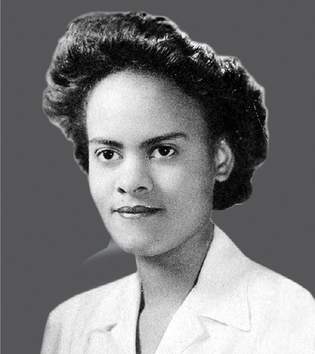
1945 Smith College Yearbook/Smith College Archives
Evelyn Boyd Granville
Mathematician
By Dylan Walsh ’11MEM
She did not know, until much later in life when her sister raised the point, that she had been the second Black woman in the country to receive a PhD in mathematics. That had never been the goal. She had simply made the decision, early on, to take advantage of opportunities that came her way. “If a door opened,” she says, “I went in.”
Growing up in segregated Washington, DC, Evelyn Boyd Granville ’49PhD was a studious child, always good at arithmetic, though she imagined a future in which she taught French. She remembers walking to the Mt. Pleasant Public Library and visiting the city’s museums, which were open to everybody; she remembers helping her mother and aunt with work on Saturdays in order to earn money for admission to the Lincoln or Booker-T or Howard theaters, where Black performers and bands put on shows for a Black audience. She was aware that discrimination defined much of her world, but she did not feel constrained by the knowledge or the fact.
Granville graduated from Dunbar High School in 1941. At Smith College, math, astronomy, and physics drew her attention away from French, and she went directly to Yale in 1945 for a doctorate in the field of functional analysis.
Her career spanned nearly 50 years and defies summary, but in December of 1955 a door opened. Granville was recruited from her job at the National Bureau of Standards to a position with IBM, where she was seated before a 650 Magnetic Drum Data-Processing Machine and asked to do programming. Three years later, NASA was formed, and the fledgling agency contracted with IBM to help launch satellites and manned capsules outward, closer to the stars, where we’ve always dreamed of venturing. Another door.
“I got to be one of the mathematicians with IBM who worked on the space program,” Granville says. She was assigned first to Projects Vanguard and Mercury, writing programs to track the orbital trajectories of satellites and rockets. Later, she joined Project Apollo, providing technical support to the engineers working to make possible a lunar landing. “Even though I was a very, very small part of that program, I was still in awe of what we were able to accomplish,” Granville says. “It was quite something. We actually went to space. We went to the moon.”
After nearly two decades in the private sector, Granville did, eventually, become a teacher. It was 1967. She was living in Los Angeles, in the midst of a divorce from her first husband, and IBM was asking her to move again, to Northern California. The divorce was destabilizing enough; she said no to IBM. She wanted to stay in place. She applied to be an assistant professor of mathematics at California State University, Los Angeles, got the job, and gladly took a 50 percent pay cut. There she finished her career—sort of.
Her first retirement was 1984, when she and her second husband left L.A. for a rural 16-acre plot of land in East Texas, his place of birth. They shared a lovely, quiet home. And Granville was soon teaching again, first at the local public schools, and then at Texas College, from which she retired in 1988. Two years later she started teaching at the University of Texas in Tyler, from which she retired in 1997. She lives now in Silver Spring, Maryland. She turned 96 last May and has eased more or less fully into retired life, though she says she is tired of the constraints of lockdown: “I try to stay as busy as possible here.” If a door opens, she’s likely to go in.
 loading
loading